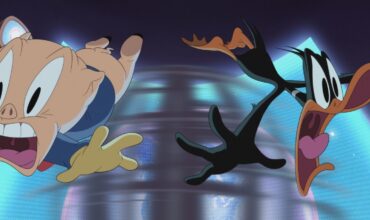THE MATRIX RESURRECTIONS is the fourth film in the Matrix franchise which began with THE MATRIX (1999) followed by THE MATRIX RELOADED (2003) and THE MATRIX REVOLUTIONS (2003). The new story apparently begins twenty-years after the events of the third film and sees the heroic figure Neo (Keanu Reeves) returned as an older version of his original identity of Thomas Anderson.
Anderson is middle-aged and is the iconic developer of a world-famous video game. He is settled in San Francisco and is getting some pressure to develop a new version of his game for current audiences. From the outside, he appears to be living a good life. However, he feels unsettled. He has an analyst (Neil Patrick Harris) who helps Anderson through his growing anxieties and he is plagued with dreams showing him visions of a very different, chaotic and dangerous universe than the one he is living in. He is also disturbed by the sight of a real-life woman who bears an uncanny resemblance to the video game character Trinity (Carrie-Anne Moss).
Is Thomas Anderson a rich, famous games designer or is he living in a brilliant simulation that is preventing him from seeing the truth?
The creators of the Matrix universe, sisters Lana Wachowski and Lilly Wachowski, have stated publicly, numerous times, that the Matrix story was completed with the third film of the trilogy in 2003. However, Warner Bros Pictures have had screenwriter Zak Penn developing a Matrix sequel for many years. News on what this story is and what timeline it occupies, has never been revealed, except that Penn has tweeted that it is not a reboot. The announcement of Lana Wachowski’s The Matrix Resurrections knocked this other project out of the general conversation but Warner Bros. could still be developing this project as The Matrix 5.
Lana Wachowski has stated that her reason for continuing the universe was as a response to the death of her parents. She says that her resurrection of the characters of Neo and Trinity was something of a psychological comfort to her. Interestingly, the very same loss is the reason Lilly Wachowski has said she didn’t want to return to the Matrix universe. Lana Wachowski and team have committed mostly to the Trinity/Neo love story. That is the human element that is supposed to capture our emotions. Trinity is also given something of a shuffle in terms of her role and status in the Matrixverse.
Although these choices makes sense given the cast available, the initial quartet of Neo, Trinity, Morpheus and Agent Smith defined the original story. Hugo Weaving was set to play Agent Smith again, but Covid-obstacles and a play he was working on prevented this. Apparently, Laurence Fishburne would have played Morpheus again had he been asked. I believe their absence leaves a hole in the narrative, that is not sufficiently dealt with. This is despite the multitude of options offered in the screenplay by writers Aleksandar Hemon and David Mitchell (no, not Peep Show’s David Mitchell.) The not-quite-Morpheus and the not-quite Smith are presented in vague terms that supposedly opens up possibilities, but actually makes all plans and missions feel somewhat ungrounded and uninvolving. The enemy has changed, sorta and so have the heroes, kinda. This seems to be an attempt at nuance and recognition of how the world has transformed in two decades, but I was left wondering what are they fighting for? (Thank you Country Joe and The Fish.)
The Matrix Resurrections is mainly about enticing fans with Neo and Trinity and the notion of seeing them 20 years later. Lana Wachowski has taken this opportunity both for fan service and to parody the very idea of sequels and their actual worth. Warner Bros are cheekily name-checked and the film’s characters discuss the point of further episodes of established successful stories. This is also used to introduce the variations of characters who now have different actors playing them. The new Morpheus is played by Yahya Abdul-Mateen II. It’s a fun and energetic performance. Jonathan Groff’s Agent Smith is less engaging. Both actors have the very difficult task of taking on iconic roles that have a serious fan base for Fishburne and Weaving. Other new actors in the Matrix 4 are Jessica Henwick, Toby Onwumere, Max Riemelt, Eréndira Ibarra, Priyanka Chopra, Andrew Caldwell, Brian J. Smith, Ellen Hollman, and Christina Ricci. Lambert Wilson, and Jada Pinkett Smith reprise their roles from the previous films.
The action part of the movie is obviously as important as ever, but is nowhere near as well-done as it was. This is proved within the movie itself as we flip into cathode-ray, green tinted archive scenes of the of the original trilogy. The current fights aren’t as well-staged, the shots aren’t as cleanly-composed and the sequences aren’t as tightly edited. The first Matrix movie borrowed brilliantly from Hong Kong action cinema, anime and the writings of Lewis Carroll and William Gibson to create a world that seemed to be a potential, terrible future. This cyberpunk dystopia affected fashion, our conception of the Internet and even turned the idea of the red pill and the blue pill into a cultural symbol for some.
There is no way that the Matrix 4 can compete with any of that. Just to make sure I wasn’t giving this fourth offering a hard time due to excessive nostalgia, I went back and re-watched at the first Matrix movie. It remains a brilliant piece of science-fiction movie-making. It made me miss original Morpheus and Agent Smith even more. What we get with this new sequel is an entertaining movie that rejigs the original material in a way that is interesting at times, confusing at others and never, at any point, essential.
Running time 2 hours and 16 minutes. Rating 6/10.




